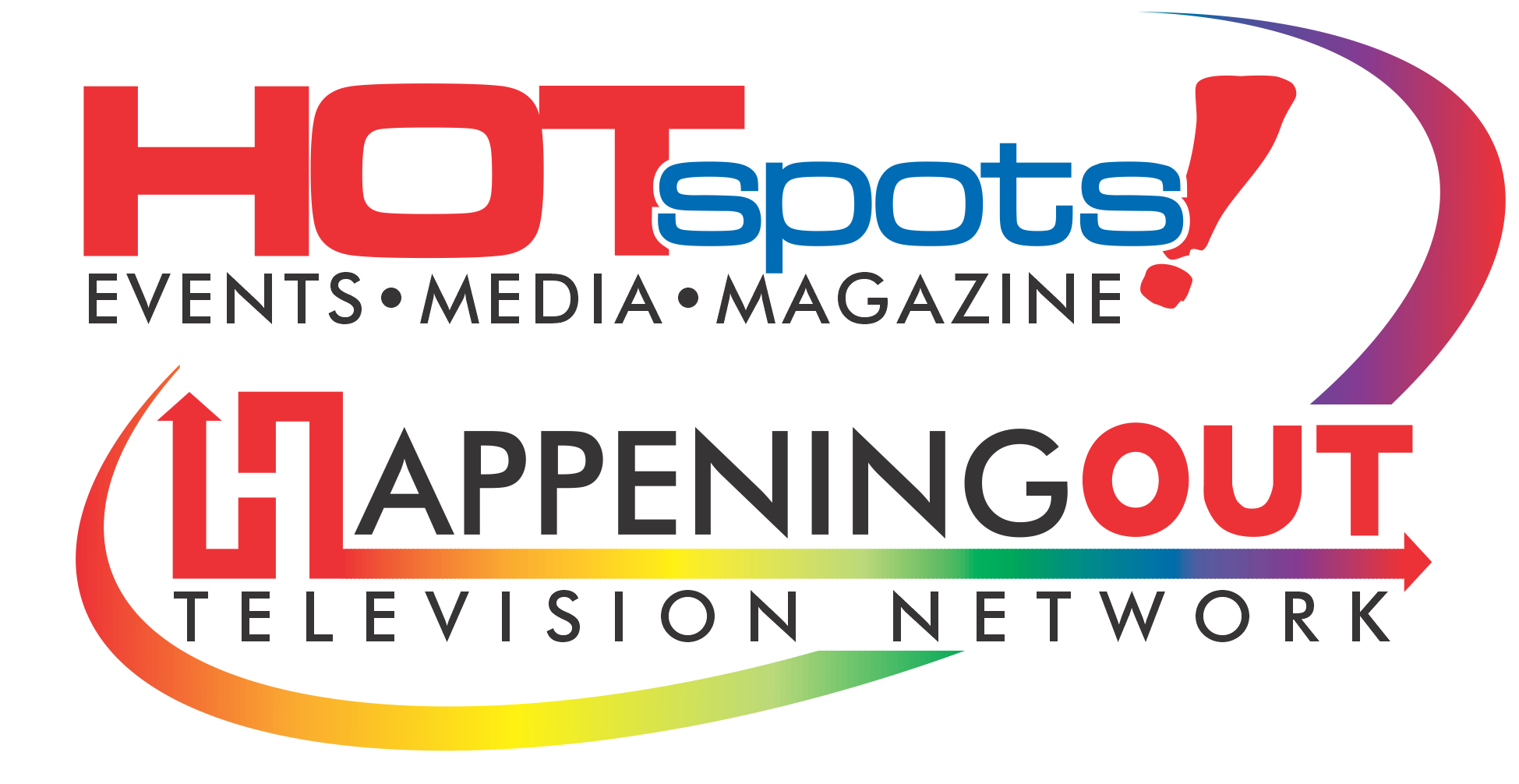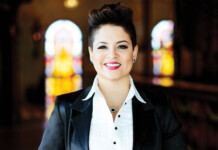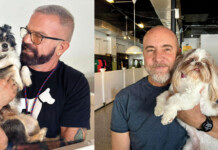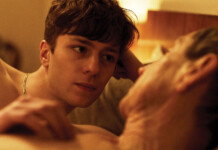
The Florida Gay Rodeo Association (FGRA) is holding a fundraiser in the run-up to the 8th Sunshine Stampede in Davie. The FGRA will be screening the documentary film “Queens & Cowboys: A Straight Year on the Gay Rodeo” on Thursday, April 3 at the Gateway Classic Theater (1820 Sunrise Blvd., Fort Lauderdale). Presented by Bryan Hodges, Clint Hummon, and Todd Garrett, the screening will start at 7:30 p.m. and will be followed by a Q&A with producer Matt Livadary.
“Queens & Cowboys” is a documentary which follows filmmaker Matt Livadary across North America in his quest to experience the rodeo life. A city boy, Livadary was fascinated with cowboys and the rodeo for as long as he could remember. Shortly into his journey, he crossed  paths with the International Gay Rodeo Association (IGRA), and chronicled the organization and the people in it for the next year. As a straight man, he learned a lot about the gay rodeo culture in the United States and gained a nationwide network of friends in the process.
paths with the International Gay Rodeo Association (IGRA), and chronicled the organization and the people in it for the next year. As a straight man, he learned a lot about the gay rodeo culture in the United States and gained a nationwide network of friends in the process.
If you’d like to purchase a ticket to “Queens & Cowboys” at the Gateway Classic Theater, you can do so by going to the FGRA website’s special Queens & Cowboys page at fgra.org/queencowboys.asp. There are limited tickets for this special showing, so don’t delay.
I got to speak to both Matt Livadary and FGRA founder Todd Garrett, and I present to you two special Hotspots interviews.
Mike Halterman: You said you were interested in cowboys and the rodeo from a young age. What exactly drew you to those things?
Matt Livadary: My dad took me to my first rodeo when I was 3 years old in Cody, Wyoming. To a kid from Los Angeles, this was hugely influential on me. I came back, got a rocking horse, a hat, a cap-gun and a buckle that I wouldn’t take off for any occasion. Something from that one moment stuck with me — some sort of cowboy nostalgia, the love of the Wild West and the way it all began. Rodeo exudes all of those qualities and is about as rugged and tough a sport and lifestyle as there is. While I didn’t grow up to become a cowboy myself, the icon has always stuck with me, intrigued me and when I set out to tell the story I knew I wanted to explore the world more.
How did you, as a straight person, cross paths with the International Gay Rodeo Association?
I worked in development at a production company in Hollywood — we were trying to find TV show ideas. All I knew was I wanted it to be set in the world of rodeo. So I was on a research trip going to traditional rodeos all over the US, soaking in the culture, meeting everyone I could and learning about rodeo. I was enamored by the rodeo community — it’s so fun, family oriented and ethereal — but I was also definitely aware of how homogenous it was. There rodeo community has a reputation of being a “good ol’ boy network” that basically means you have to have been born into this ranching lifestyle as a white male cowboy in order to be in the club. I’m a white male, but even just being a rodeo-outsider from the city, I was made fun of for driving a Toyota, for wearing khakis, little stuff that wasn’t very serious but I could have only imagined how out of place I might have been made to feel had I been a minority or a gay man. So when I learned of the gay rodeo on that trip, I immediately understood why the distinction was necessary. I was immediately intrigued and had to learn more. So I left my job and devoted myself to filming a documentary on the IGRA — truth is far more interesting than anything I could have ever scripted.
Did you have preconceived notions or opinions about gay people that changed as a result of chronicling the gay rodeo and the people involved in it?
Popular media has fallen in love with featuring gay characters, but in my opinion, the LGBT community is still only featured in very narrow stereotypes — turn on any coverage of a gay pride parade, and all that makes it on the news are the extreme participants in speedos and feathers. Even media outlets that feature gay rodeo coverage typically only feature its unique camp events (drag queens on steers, underwear on goats, etc). It’s easy to get conditioned into believing those stereotypes are the norm and miss the rich variety of everyday people who comprise the community.
I’m comfortable enough now to admit that when I first started this project, I was shocked at how diverse the gay community really is — I realize how naive this is to say, which I think is why I first felt the project was important. I wasn’t a bigot or a homophobe by any stretch, in fact I always considered myself a champion of LGBT equality — so if I could still have these misconceptions, I knew there were many who similarly hadn’t stepped out of their comfort zones. I set out to reach that audience, and in order to do so, it really meant expanding my own understanding of how both the straight and LGBT communities view each other. It meant starting a conversation between the two groups, which is what I hope this film ultimately does.
Out of all the stories that are told in your documentary, which one most moved you, and why?
Being from the city, it can seem as though being gay is a non-issue these days. Even in the last 10 years, we’ve come so far as a society in terms of acceptance — turn on any TV station and it’s almost trendy to be gay. So for me it was easy to think that everything’s totally copacetic. But when I traveled to rural communities, it became very clear to me that there are still two Americas.
I was filming a hoedown after one of the gay rodeos in Texas when a man approached me, terrified — he told me he didn’t want to be filmed. He explained he was a teacher in Texas and wasn’t out in his community. He said if they found out he was gay, he’d immediately lose his job and be disowned by his family. He begged me not to out him and said the gay rodeo was really the only place he could go. That story hit me hard and upped the stakes of everything. I would film for three more years and learn that his story was shared by many I encountered. I hope this film reaches those communities and those individuals and empowers them to live openly and authentically.
Why should people see this documentary?
There’s a great amount of heart and honesty in this film that I think has started to connect with audiences. This is not a gay story, it’s not a straight story. It’s a story about people and the courage and perseverance it takes to live authentically.
What message do you want people to take away about the IGRA after viewing this documentary?
That there’s a place for all of us to belong, and for a lot of people, the gay rodeo provides a welcoming family that represents the essence of the cowboy code — a group that lends a helping hand to all, strives to bring out the best in each and accepts any and all as equals.
—
Mike Halterman: Tell us what the FGRA is raising money for, with regard to the April 3 showing of “Queens and Cowboys.”
Todd Garrett: FGRA fundraises throughout the year to support charities and our community. “Queens and Cowboys” is an FGRA royalty fundraiser for Camp Dream Oaks, a camp for children with disabilities located in Bradenton. This camp utilizes a equine riding therapy program.
I asked Matt Livadary this question, and I would like your answer too: After viewing the documentary, what would you hope is the message that people take away about the IGRA?
Everyone would like to be part of and accepted in a group. For a lot of people, whether they are from the city or the country, it’s rodeo. We all strive to live by values and ethics. We will lend you a hand, help you be the best you can be, compete against you, and still welcome you with open arms regardless of your sexual orientation, gender, race, or religion.
Florida has such a mix of urban and rural landscapes, but South Florida in particular is quite urban. What can a “city boy” or “city girl” get out of attending a gay rodeo or becoming involved with the FGRA?
FGRA’s Sunshine Stampede Rodeo and all other IGRA-sanctioned rodeos provide entertainment for everyone – gay, straight, or children. It’s a great way to spend a day watching a sport that is open to anyone who would like to learn while at the same time supporting the community and charity.
We welcome anyone that wants to become involved. If you live in a condo on the beach or on a ranch, there is something that entices everyone. FGRA is NOT just the Sunshine Stampede Rodeo, we have other fundraisers and events throughout the year. Whether it’s a Rodeo and Polo Day at the polo fields, a campout, trail ride, canoe trip, barbecue and bonfire, baseball game, or attending a NHRA/IHRA drag race, we strive to provide something that may appeal to everyone.
FGRA supports many local charities. Which ones do they support, and how does FGRA help the charities do their work? Do FGRA members volunteer their time, money, etc.?
Since its founding in 2005, FGRA has supported charitable organizations throughout the state such as Camp Dream Oaks, EASE Foundation, Poverello, Camp Boggy Creek, ASAP, SunServe, GLBCC Orlando, and Broward House to name a few, through the donation of money. Additionally FGRA members have donated time from everything from helping and/or participating with an anti-suicide 5k run/walk, to providing a water stop for horseback riders participating in the historic cross-state reenactment of the Florida Cracker Trail drive.
Do people involved in FGRA compete in mainstream “straight” rodeo events? Are there any parallels or differences between gay rodeo events and “straight rodeo”?
FGRA and any IGRA member association, opens its arms to anyone, whether you are gay, straight, bisexual, or transgendered, anyone who wishes to learn and/or compete is welcome at any IGRA sanctioned rodeo. Several FGRA members compete on other rodeo circuits. We have gay members such as myself who compete on the IGRA, CPRA, Ranch Rodeo, and the local rodeo circuit, as well as straight members such as Luke Lancaster, his wife, brother, sister-in-law, and mother who compete on the IGRA circuit and PRCA circuit.
With regard to events, most events, regardless of the circuit (except the ranch rodeo circuit) parallel each other. The main difference is on most “straight” rodeo circuits, the women are only allowed to compete in speed events and men in the rough stock events. IGRA is the only sanctioning body that allows every event to be open to anyone. Women compete against women, men against men. So you will have men that will barrel race and women that will bull ride. All rodeo circuits have “camp” events. Several of these circuits utilize steer deco. However, it’s only on the IGRA circuit where you will see people putting underwear on goats (Goat Dressing) and someone in camp drag on a steer (Wild Drag Race).
If someone’s interested in joining the FGRA, what do they need to do and who do they need to talk to?
If someone is interested in joining FGRA, they can stop by the FGRA table at the Sunshine Stampede Rodeo or any event in which FGRA is present, they can ask any of our officers or royalty team members, or they can go to our website at http://www.fgra.org/ where they can obtain a membership application. All FGRA events are also listed on the FGRA facebook page.
The 8th Sunshine Stampede will be held at the Bergeron Rodeo Grounds in Davie from April 4-6. To read more about this event, see our article that was published in the March 27 issue at hotspotsmagazine.com/2014/03/25/florida-gay-rodeo-association-presents-the-8th-sunshine-stampede.














